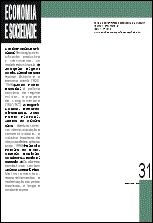Abstract
O artigo apresenta um modelo Norte-Sul no qual a taxa de crescimento de longo prazo do Sul depende do aprendizado tecnológico e da mudança estrutural. Adota-se como ponto de partida o modelo de crescimento com restrição no Balanço de pagamentos, que permite identificar as condições necessárias para a convergência sustentável. Mostra-se que essa convergência requer que o cociente entre as elasticidades renda das exportações e das importações seja maior do que a unidade. Por sua vez, essas elasticidades são função do padrão de especialização. O modelo permite estudar como a interação entre a dinâmica do hiato tecnológico e da estrutura produtiva definem a taxa relativa de crescimento Norte-Sul e os salários relativos. Também são discutidos os efeitos da política e das instituições através de variações em alguns dos parâmetros mais importantes do modelo.
Abstract
Technology, productive diversification and growth: structuralist model structuralist model The paper presents a North-South model in which the long run rate of growth of the South depends on technological learning and structural change. It takes as a point of departure the Balance-ofPayments-constrained growth model, which provides useful insights on the necessary conditions for sustained convergence. It is suggested that this requires that the ratio between the income elasticity of the demand for exports and imports to be higher than the unity. In turn, income elasticities are a function of the technology gap and of the patterns of specialization of the economy. The model allows for discussing how the interplay between the productive structure of the South and the dynamics of the technology gap shapes North-South relative rates of growth (and hence convergence or divergence) and relative wages in the long run. The paper also addresses the influence of policy and institutional variables by allowing key parameters in the model to vary.
Key words: Structuralist macroeconomics. Economic growth. Innovation and technologic diffusion. Conditional convergence
References
BRESSER-PEREIRA, L. C.; NAKANO, Y. Crescimento econômico com poupança externa? Revista de Economia Política, v. 23, n. 2 (90), p. 1-25, abr./jun. 2003.
CIMOLI, M. Technological gaps and institutional asymmetries in a North-South Model with a continuum of goods. Metroeconomica, 39, p. 245-274, 1988.
CIMOLI, M.; PORCILE, G.; PRIMI, A.; VERGARA, S. Cambio estructural, heterogeneidad productiva y tecnología en América Latina. In: CIMOLI, M. (Ed.). Heterogeneidad estructural, asimetrías tecnológicas y crecimiento en América Latina. Santiago de Chile: Cepal/BID, 2005.
DOSI, G.; PAVITT, K.; SOETE, L. Technology and international trade. Edgar Elgar, 1990.
FAGERBERG, J. Why growth rates differ. In: DOSI, G.; FREEMAN, C., SILVERBERG, G.; SOETE, L. (Ed.). Technical change and economic theory. London: Cambridge University Press, 1988.
FAJNZYLBER, F. Industrialización en América latina: de la caja negra al casillero vacio. Cuadernos de la Cepal, Santiago de Chile, CEPAL, 60, 1990.
HAUSMANN, R.; HWANG, J.; RODRIK, D. What you export matters. John F. Kennedy School of Government, Harvard University, Dic. 2005. (Working Paper, RPW05-063).
KRUGMAN, Paul. Differences in income elasticities and secular trends in real exchange rates. European Economic Review, May 1989.
MCCOMBIE, J. S. L.; THIRLWALL, A. P. Economic growth and balance of payments constraint. New York: St Martin’s Press, 1994.
MORENO-BRID. O capital inflows and the balance-of-payments constrained growth model. Journal of Post-Keynesian Economics, v. 21, n. 2, p. 283-298, winter 1998-99.
NARULA, R. Understanding absorptive capacities in an innovation systems context: consequences for economic and employment growth. DRUID Working Paper, n. 04-02, Dec. 2004.
NELSON, R.; PACK, H. The Asian miracle and modern growth theory. The Economic Journal, Royal Economic Society, Blackwell Publishers, 109, p. 416-436, 1999.
NELSON, R; PHELPS, E. Investments in human, technological diffusion and economic growth. American Economic Review; 61, p. 69-75, 1966.
PATEL, P.; PAVITT, K. Uneven (and divergent) technological accumulation among advanced countries: evidence and a framework of explanation. In: DOSI, G.; TEECE, D.
J.; CHYTRY, J. Technology, organization and competitiveness. Oxford University Press, 1998.
PENEDER, M. Tracing empirical trails of Schumpeterian development. Papers on Economics and Evolution, Max Planck Institute for Research in Economic Systems, Viena, 2002.
PREBICH, R. El desarrollo económico de América Latina y sus principales problemas. Comisión Económica para América Latina, 1949. (Documento E/CN 12.89).
PREBICH, R. Capitalismo periférico: crisis y transformación. México: Fondo de Cultura Económica, 1981.
ROS, J. Development theory and the economics of growth. Ann Arbor: The University of Michigan Press, 2000.
RODRÍGUEZ, O La teoría del subdesarrollo de la Cepal. Mexico: Fondo de Cultura Económica, 1980. (8. ed., 1993).
SETTERFIELD, M. The economics of demand-led growth. Challenging the supply-side vision of the long run. Cheltenham: Edward Elgar, 2002.
THIRLWALL, A. P.; HUSSAIN, M. N. The balance of payments constraint, capital flows and growth rates differences between developing countries. Oxford Economic Papers, 10, p. 498-509, 1982.
VERSPAGEN, B. Uneven growth between interdependent economies. London: Avebury, 1993.
A Economia e Sociedade utiliza a licença do Creative Commons (CC), preservando assim, a integridade dos artigos em ambiente de acesso aberto.


